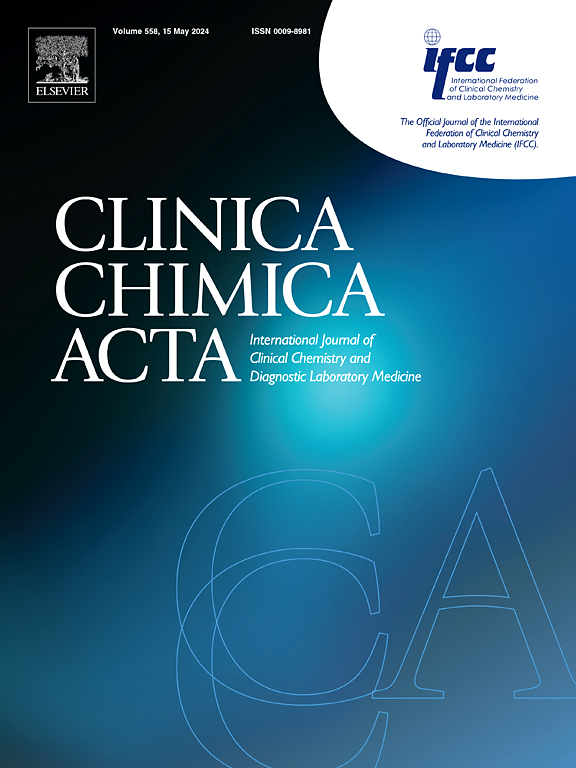Comparison of the newly formulated beckman access free T4 (Thyroxine) assay on the DXI 800 analyzer with the current Beckman free T4 (Thyroxine) assay for biotin Interference: New assay is free from biotin interference
IF 3.2
3区 医学
Q2 MEDICAL LABORATORY TECHNOLOGY
引用次数: 0
Abstract
Background
Biotin causes significant positive interference with Free T4 (thyroxine) measurement using the current Beckman assay. Recently, Beckman reformulated the FT4 assay to overcome biotin interference. We compared the effect of biotin on both current and newly formulated FT4 assays.
Materials and Methods
Three serum pools were prepared using specimens containing various amounts of FT4. Aliquots of each pool were supplemented with various amounts of biotin. Then FT4 concentrations were measured by both the current and new FT4 assay. In addition, three volunteers ingested 10 mg of biotin. Specimens were drawn prior to the administration of biotin and 2 h post-biotin ingestion. FT4 concentration was measured before and after biotin administration using both assays.
Results
The newly formulated FT4 assay correlated well with the current FT4 assay. In the presence of biotin, FT4 concentrations were increased significantly using the current assay. However, negligible changes were observed using the newly formulated assay. We also observed similar results in vivo within the volunteer specimens.
Conclusion
The newly formulated Beckman Access FT4 assay is free from biotin interference up to a very high biotin concentration of 3500 ng/mL.
DXI 800分析仪上新配制的贝克曼游离T4(甲状腺素)测定法与现行的生物素干扰贝克曼游离T4(甲状腺素)测定法的比较:新测定法不受生物素干扰。
背景:生物素对当前贝克曼测定游离T4(甲状腺素)有显著的正向干扰。最近,Beckman重新制定了FT4检测方法,以克服生物素的干扰。我们比较了生物素对当前和新制定的FT4测定的影响。材料和方法:用含有不同量FT4的标本制备3个血清池。每个池的等量添加不同数量的生物素。然后用现有的和新的FT4方法测量FT4浓度。此外,三名志愿者摄入了10 毫克的生物素。在给予生物素之前和摄入生物素后2 h提取标本。用两种方法测定生物素给药前后的FT4浓度。结果:新建立的FT4检测方法与现有的FT4检测方法具有良好的相关性。在生物素存在的情况下,使用当前的分析,FT4浓度显着增加。然而,使用新配制的检测方法观察到的变化可以忽略不计。我们在志愿者体内也观察到类似的结果。结论:新配制的Beckman Access FT4检测不受生物素干扰,生物素浓度高达3500 ng/mL。
本文章由计算机程序翻译,如有差异,请以英文原文为准。
求助全文
约1分钟内获得全文
求助全文
来源期刊

Clinica Chimica Acta
医学-医学实验技术
CiteScore
10.10
自引率
2.00%
发文量
1268
审稿时长
23 days
期刊介绍:
The Official Journal of the International Federation of Clinical Chemistry and Laboratory Medicine (IFCC)
Clinica Chimica Acta is a high-quality journal which publishes original Research Communications in the field of clinical chemistry and laboratory medicine, defined as the diagnostic application of chemistry, biochemistry, immunochemistry, biochemical aspects of hematology, toxicology, and molecular biology to the study of human disease in body fluids and cells.
The objective of the journal is to publish novel information leading to a better understanding of biological mechanisms of human diseases, their prevention, diagnosis, and patient management. Reports of an applied clinical character are also welcome. Papers concerned with normal metabolic processes or with constituents of normal cells or body fluids, such as reports of experimental or clinical studies in animals, are only considered when they are clearly and directly relevant to human disease. Evaluation of commercial products have a low priority for publication, unless they are novel or represent a technological breakthrough. Studies dealing with effects of drugs and natural products and studies dealing with the redox status in various diseases are not within the journal''s scope. Development and evaluation of novel analytical methodologies where applicable to diagnostic clinical chemistry and laboratory medicine, including point-of-care testing, and topics on laboratory management and informatics will also be considered. Studies focused on emerging diagnostic technologies and (big) data analysis procedures including digitalization, mobile Health, and artificial Intelligence applied to Laboratory Medicine are also of interest.
 求助内容:
求助内容: 应助结果提醒方式:
应助结果提醒方式:


